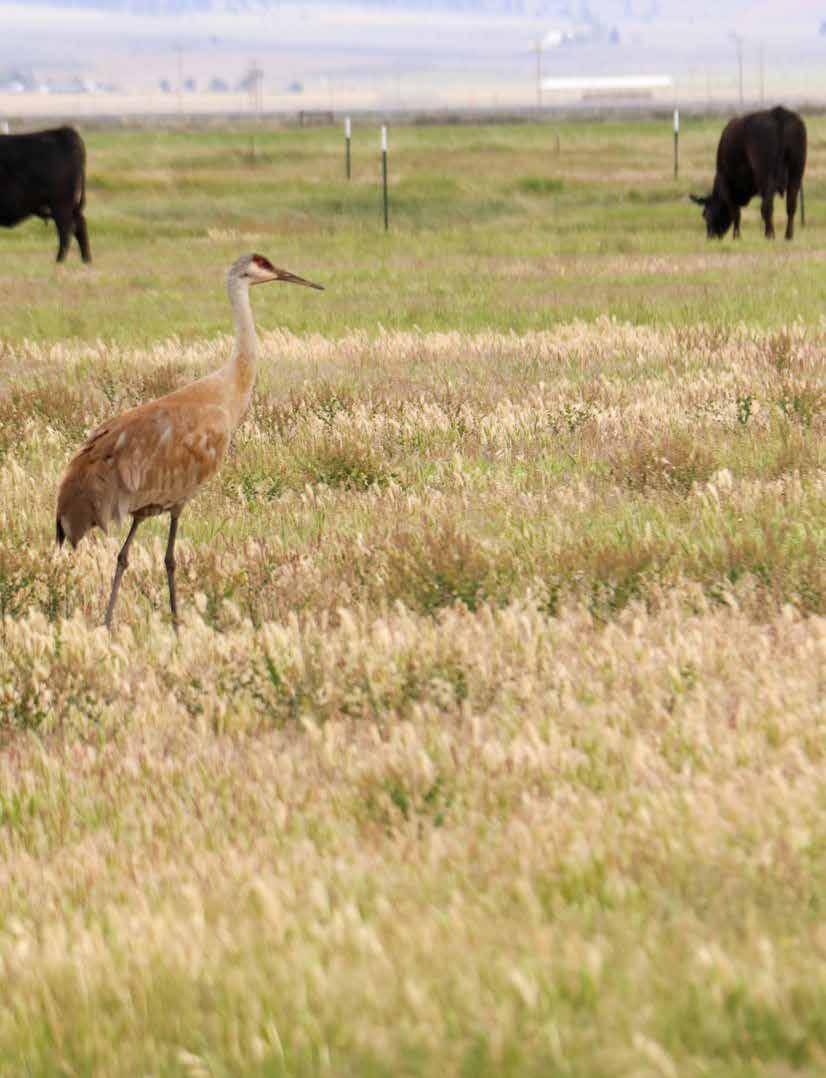
16 minute read
Ranching crucial to Mother Nature
RANCHING MATTERS
Rangelands remain essential for wildlife
Advertisement
by CCA Director of Communications Katie Roberti
24 California Cattleman June 2020 F or months, Californians have been sheltering in place due to stay at home orders resulting from the COVID-19 pandemic. Although counties are seeing some restrictions lifted after a spring like no other, it’s safe to say summer activities this year won’t look normal for most of the Golden State’s residents.
While 2020 hasn’t shaped up to be what most people were expecting, birds migrating through the state this spring have not participated in the stay at home orders. Every year regardless of what people are dealing with, society-altering pandemics included, up to a billion birds migrate north through California on the Pacific Flyway.
As hundreds of wildlife species pass through the state, ranchers and the over 38 million acres of public and private rangeland they manage play an essential role in hosting the birds for their stay, as well as providing habitat for hundreds of other species throughout the year.
For wildlife, agriculture is an essential service.
“We raise so much more than cows, sheep and hay.” Dave Goicoechea, a farmer and rancher in Sierra Valley says.
In addition to the livestock they are raising, producers see many other species on their land, a testament to the good work and stewardship being done. Well-managed ranches generate more than just income.
While farmers and ranchers have to make a profit to pay the bills, Goicoechea — a retired biologist for the Bureau of Land Management’s Nevada office — believes
most livestock producers care about wildlife, the land and so much more.
“When we take care of our cattle, it’s taking care of the ground for other species,” Goicoechea says—something he has seen firsthand.
Today, Goicoechea and his family enjoy experiencing the geese, ducks, sandhill cranes, deer, and even the occasional bears that pass through their property, but he says 30 years ago when his family bought the land their ranch is located on, this abundance of wildlife did not exist. It has taken dedication, hard work and a million management decisions to get the ranch to where it is today.
Managing water, maintaining habitats and keeping natural resources available are just a few of the critical decisions ranchers make that influence wildlife.
Similarly, Goicoechea says the preserved beauty of the Sierra Valley hasn’t just happened, “People have worked really hard for a very long time to make the valley the way it is.”
Sandhill cranes have started coming more and more regularly to the Goicoechea’s ranch. Relatedly, other ranchers in the valley never thought they would see osprey, river otters, antelope or the other species on their ranches that now have a presence in the valley.
While ranchers have the availability to provide habitat that attracts new species on the land they manage, protecting the wildlife that has been on the land for generations is also a goal.
For Tim Koopmann in Alameda County, there are a
few specific critters his family has watched over on their ranch that has been in his family since 1918. Working closely with the Ohlone Audubon Society for the past 15 years, the western bluebird is one of the species the family has been dedicated to protecting.
“We agreed to provide space for them to put nesting boxes,” Koopmann says. “It led to where we are today with 92 boxes.”
In one of the reports on the project — sent annually to Cornell University — the ranch was described as a “virtual bird factory.” A title, Koopmann, says he is proud of for his ranch, “It means we are doing something right holistically while remaining economically viable.”
What started with the family being approached about a presentation of western bluebird recovery, turned into what has “been an amazing project for us to observe,” Koopmann says.
In addition to the work the Koopmanns have done with the Ohlone Audubon Society on the recovery of the western bluebirds, for the past 12 years the group has also been able to monitor and collect data on a nesting pair of golden eagles at the ranch.
Outside of collaborating with the local Audubon Society, the Koopmanns have also committed to helping all species of birds safely drink out of the water troughs on their ranch.
“Every one of our water troughs has an escape ramp,” Koopmann says.
The escape ramps enable the birds to walk down to the water and get a drink without the possibility of becoming trapped in the trough. Experimenting with making different models of the escape ramps out of steel, wood and concrete, the family has mastered the design of these lifesaving mechanisms.
Beyond the birds, through conservation easements, the Koopmann family is committed to the recovery of two other species; the Callippe Silverspot Butterfly and the California Tiger Salamander, both of which are state and federally listed on the California Endangered Species Act and federal Endangered Species Act. Through the easements — which helped the family save their ranch after being left with an unimaginable fee from the federal and California estate taxes — the species have the habitats and resources they need for survival. Managed grazing is critical to the populations of both species.
For the salamanders, it’s a breeding pond, managed just like any other pond is on their operation. Koopmann says without grazing, the breeding pond would not be able to be used by the species as the site would grow up and the salamanders with their small legs could not get to the pond.
For the butterflies, it’s the Johnny Jump Up (Viola tricolor) flowers they require for their lifecycle. These wildflowers continue to grow on the ranch because they are moderately grazed.
“We are providing an essential service with grazing,” Koopmann says.
Just as how in the absence of managed grazing there would not Johnny Jump Ups, if there were an absence of ranches across the Golden State there would not be as much land available for wildlife.
The Koopmann’s ranch in the Bay Area is just one example of rangelands that are now surrounded by urban development. In the United States every hour, 175 acres of agricultural land is lost to development—three acres lost every minute, according to The American Farmland Trust. This is a threat not just to the farmers and ranchers producing food for people throughout the world, but to the wildlife dependent on these lands.
In the Sierra Nevada Foothills, where there are still some large intact ranches, Dan Macon, University of California Cooperative Extension Livestock and Natural Resources Advisor for Placer, Nevada, Yuba and Sutter Counties, says ranches in the region help wildlife in terms of avoiding habitat fragmentation.
“Because ranching is still economically viable here, we still have wildlife,” Macon says.
Relatedly, Matthew Shapero, University of California Cooperative Extension Livestock and Range Advisor for Ventura and Santa Barbara Counties, notes the tremendous amount of value ranchers and rangeland provide in Southern California for wildlife.
While this year has brought changes for many, it hasn’t changed the fact that livestock producers provide essential services to wildlife. Admittedly, there are some species — including mountain lions bears and wolves — ranchers would welcome fewer visits from as predators continue to have increasingly detrimental impacts on livestock herds. But producers are working hard to find critical solutions for conflicts with predators to ensure livestock can be protected, farmers and ranchers can remain economically viable and the essential services ranching provides can continue to endure for years to come.
Johnny Jump Up wildflowers continue to grow on the Koopmann Ranch because of well managed grazing.

To the left, Sandhill Cranes can often be spotted in fields next to cattle grazing in Sierra Valley.
The California Cattlemen’s Association (CCA) is working closely with researchers at the University of Wyoming to analyze the non-grazing-fee costs of grazing livestock on public lands (the research is funded by CCAaffiliate the Public Lands Council). While our research on public lands is well-underway, we need data on the costs of grazing livestock on privately leased land to round out the study. Data on the non-fee costs of grazing on public lands has no value in a vacuum; we need data about the costs of running cattle and sheep on privately leased land as a ‘baseline’ against which to compare those results.
If you lease privately-owned rangeland to graze cattle or sheep, please consider participating in this study. One benefit of this study is that it provides us hard data to combat radical environmentalists’ slander that public lands ranchers are ‘welfare ranchers’ based on their willful disregard of the time, money and other resources that ranchers put into improving our public lands. That data is useful in engaging Congress, federal land management agencies and the public. But hard data on the costs of grazing privately leased rangeland will be much more than a ‘baseline’ for the



Earlier this year, the survey titled “Factors influencing bull selection decisions and management in extensive rangeland production systems of the western United States” was mailed out. The survey is now available to be taken online at: http://ucanr.edu/bullsurvey.
CCA partnered with Cal Poly, UC Cooperative Extension and California State University, Chico, to launch this survey sponsored by the California Beef Cattle Improvement Association. All involved greatly appreciate CCA members taking 20 minutes to complete the anonymous survey and submitting their results online or by returning them in the prepaid envelope. Results will be shared in a future edition of the California Cattleman.
26 California Cattleman June 2020 Reminder: Participate in the CCA Membership Survey on Bull
Purchase and Management, Now Available Online
study, it will provide CCA with hard data useful in educating state legislators and regulators seeking to regulate private rangelands.
Non-fee grazing costs research first began in the 1960s and extended into the 1990s but has not been updated in 20 years. The current project will provide an update on differences in total cost of grazing livestock on private and public land over time (or note if no real change has occurred). The information gained from this research could be used to develop a trend in total costs that can be used for future research and policy.
If you lease private land to graze livestock and are willing to assist CCA by participating in this research, please contact Kasey Dollerschell, the UW graduate student spearheading the study, at kdoller1@uwyo.edu or (970) 589- 9339. Kasey has a quick survey that can be filled out over the phone or sent out and returned via USPS or email.
Finally, if you have received a packet pertaining to federal allotments for this study we urge you to respond to Kasey, as well.
“This survey gets at the core fundamentals of beef production, sire selection and management,” states Anthony Stornetta, San Luis Obispo County Cattlemen’s President. “As a commercial cattleman, I am interested in the results of the survey that will focus on what cattlemen are doing across the West and how I can use the results to improve my operation.”
If you have any questions or would like a paper copy of the survey please contact Zach McFarlane Cal Poly, San Luis Obispo at (805) 756-2685 or zmcfarla@calpoly.edu.

The most cost effective forage a cow can consume is the forage she can harvest herself. However, protein often times becomes the most limiting nutrient for cattle grazing crop residues and dormant grass pastures. In these situations protein supplementation is required to efficiently harvest energy from these protein deficient forage-based diets.
Contact Conlin Supply to learn more about SmartLic ® protein tubs!
Albert Conlin | 209.652.2783 Craig Edling | 209.531.7037 craig.edling@aol.com

Inquire about full truckload pricing and ranch deliveries.
NEW GENERATION SUPPLEMENTS Anna Bavor 650.575.5612 annab@newgensupplements.com
www.smartlic.com
SmartLic ® is a registered trademark of Animal Feed Supplement, Inc. dba New Generation Supplements. © 2020 New Generation Supplements
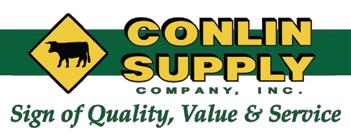
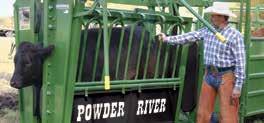
CALF EQUIPMENT GATES AND PANELS CATTLE GUARDS & MORE!

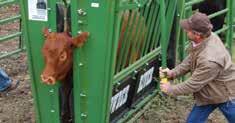
SQUEEZE CHUTES HEAD GATES CATTLE WORKING SYSTEMS
Since 1938, Powder River has provided the highest quality and most durable products available for the livestock industry. Conlin Supply Co. carries the full line of Powder River’s squeeze chutes, working systems, classic gates and panels which are unsurpassed in quality, functionality and reliability, making them an overall great investment. Stop by either of our locations to see the full line of products...
For many years, CBCIA has recognized youth across the state for meeting particular standards set forth by the CBCIA Board of Directors. These awards are recognition beyond the awards given by the respective county fairs across the state. In conversations with those involved in the beef processing industry in California, it was requested CBCIA re-evaluate our standards for the Carcass of Merit and Gold Seal programs as high-quality carcasses were being left out of top placings due to the emphasis on yield grade. In addition, some county officials asked us to develop a standard carcass contest scoring system to make it easier for those responsible for the carcass contests.
Therefore, the CBCIA Board of Directors evaluated the standards for their recognition program and has determined new standards starting in 2020. “The current CBCIA standards were developed about 8 years ago,” states CBCIA Board member Carissa Koopmann Rivers, Sunol. “The new standards the CBCIA board approved will better align the local youth carcass contests to current industry standards.”
CBCIA asks that county fairs use the new standards for the 2020 county fair season. The Carcass of Merit and Gold Seal awards are meant to recognize youth above and beyond the county fair carcass contests. These awards are not meant to say these carcasses are the only ones eligible for your respective carcass contests. These awards are in addition to the awards your country fair gives.
2020 CBCIA CARCASS CONTEST CRITERIA CERTIFICATE OF
MERIT GOLD SEAL
HOT CARCASS WEIGHT, LBS. 600 TO 1,000 650 TO 900
USDA QUALITY GRADE MIN. LOW CHOICE OR
HIGHER
USDA YIELD GRADE BELOW 4.00 (3.99 OR BELOW) AVERAGE CHOICE OR
HIGHER BELOW 3.0 (2.99 OR BELOW)
Additionally, we looked at several different methods used to evaluate carcass contests across the state. In consultation with Mr. Mike Smith from Harris Ranch, we determined that using the pricing grid method would be appropriate to evaluate carcass contests for ranking as it most closely follows what happens in the beef industry in terms of carcass pricing. This is only a recommendation if your county does not have a method to rank the carcasses or if your county is looking for other ways to rank carcasses. We will be posting an excel sheet for those of you who wish to use a grid system.
EXAMPLE Beef Pricing Grid for Carcass Contest
2) Add premium or subtract discounts based on Quality
Grade Characteristics 3) Add premiums or subtract discounts based on Final
Yield Grade 4) Subtract discounts based on light or heavy carcass weights
Low Choice, Yield Grade 3 (Base Price) = $192.96
Quality Grade Prime = +$12.50 Top 2/3rds Choice (High or Average Choice) = +$3.67 Select = -$15.08 Standard = -$30.27 Dairy Type = -$2.67 Dark Cutter = -$35.21 Hardbone (C, D, E Maturity) = -$34.00 Over 30 months of Age = -$19.38
Yield Grade
1.0-1.9 = +$3.86 2.0-2.4 = +$2.00 2.5-2.9 = +$1.64 4.0-4.9 = -$11.21 5.0-5.9 = -$17.79
Weight (in pounds)
400-499 = -$30.71 500-549 = -$23.80 550-599 = -$11.47 901-1000 = -$1.00 1001-1049 = -$8.00 over 1050 = -$18.00
So let’s say someone has an Average Choice, Yield Grade 2.4 carcass that weighs 750 lbs. The carcass would be worth $198.63 per cwt (per 100 pounds).
Donati Ranch, based in Oroville, initiated the reinvigoration of the carcass contest for two fairs in Butte County back in 2018 and sponsors the hosted dinner for steer exhibitors and family members. In 2019, the event drew over 100 guests to learn about beef carcasses from California State University, Chico. “I am excited to see CBCIA evolve the options for local carcass contests to include a pricing grid to rank steers,” said Tom Donati. “As a cattle producer who retains ownership of animals in the feedlot, this is the same data we use to analyze our genetics potential with profitability.”
When CBCIA started working on this article, we were in a much different place than we are today. Several county fairs have been canceled in California so far and there is little doubt that more may be canceled in the future. With that being said, if your county is still wishes to hold a carcass contest please feel free to reach out to Fresno State’s Amanda McKeith regarding carcass contests for beef, lamb, swine and goats. McKeith can be reached at amckeith@ csufresno.edu.
WSR Insurance Services: Ready to Help You Find Coverage
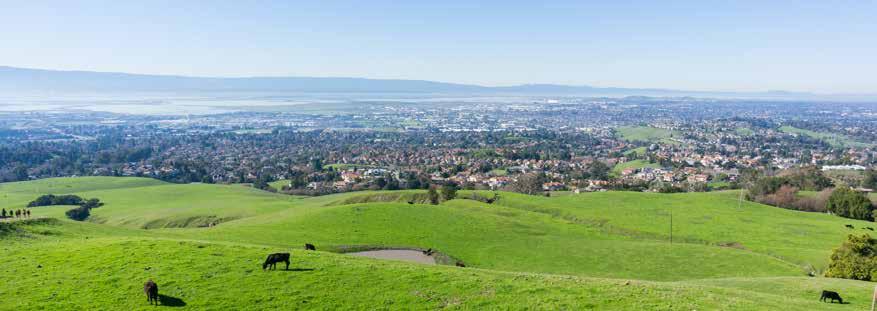
In 2019, the California Cattlemen’s Association (CCA) expanded its partnership with WSR Insurance Services (WSR). Over the last eight years, WSR has helped hundreds of CCA members with their Pasture, Range, Forage (PRF) insurance needs. In 2020, WSR will continue to partner with CCA to assist members with all their insurance needs such as Farm Property, Liability, Auto and Workers Compensation.
Over the past few years, Farm Property especially has been a very hot topic in the cattle industry because of the wildfire issues in California combined with the rural areas many of you have property. Many carriers are declining more and more accounts or pulling back on coverage in areas they deem to be at more risk. At WSR, we do all we can to push back when it makes sense to challenge the status quo the carriers have about an area. We urge them to take an individual approach to find what exposure exists at your location and surrounding it, not an issue 10 miles away.

June 2020 California Cattleman 29 We don’t always succeed in our efforts, but we have helped clients find coverage who didn’t have any luck with previous efforts. Our agents, who often come from rural backgrounds, know the exposures that exist in these areas and know how to present an account and fight to get you the best possible product. In the past couple of years, we have seen a good decrease in wildfires damaging large amounts of property. Hopefully, if this trend continues, we will start to see a little bit of relaxation in the carrier’s mindset in these areas. However, until then, WSR’s commitment to our customers and the cattle industry makes this partnership a win-win for CCA members. For more information contact:
Kevin Hoppin, CIC
kevinh@wsrins.com (530) 662-9181









